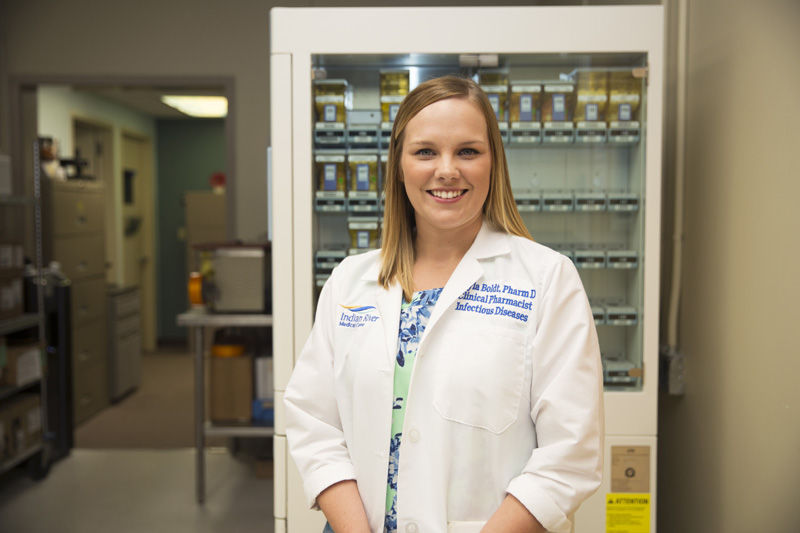Lyme disease, a bacterial in infection caused by a bite from an infected tick, is notoriously difficult to treat in some patients. Now, researchers from North¬eastern Uni¬ver¬sity in Boston believe they may have discovered why, and possibly opened the door to a more effective treatment called pulse dosing (of antibiotics).
There is some controversy about the research, however, and Dayla Boldt, an infectious diseases clinical pharmacist at Indian River Medical Center, questions whether pulse dosing is appropriate treatment for lingering Lyme disease.
According to the Centers for Disease Control and Prevention, Lyme dis¬ease affects about 300,000 people annu¬ally in the U.S. Very few people contract it in Florida, but Mary Quillinan, Doctor of Osteopathic Medicine and Fellow of American College of Osteopathic Internists, says many of Vero’s seasonal residents spend time in the states with high incidence rates, including, in order of disease prevalence, Vermont, New Hampshire, Maine, Connecticut, Massachusetts, Delaware, Rhode Island, and Pennsylvania.
If Lyme disease is caught early, it usually responds well to antibiotics and patients recover quickly. However, about 10 to 20 percent of patients who have received treatment are later diagnosed with Post-treatment Lyme Disease Syndrome; these patients may have persistent and recurring symptoms which can include arthritis, muscle pain, fatigue and neurological problems.
Note the word “persistent” in the previous sentence. The researchers, led by Uni¬ver¬sity Dis¬tin-guished Pro¬fessor Kim Lewis, found that the bacterium which causes Lyme disease also forms dormant cells called persister cells. These persister cells are known to be less responsive to treatment with antibiotics than regular cells.
Dr. Lewis and his team tested ways to get rid of the persister cells, thereby getting rid of the infection. One approach involves something called pulse-dosing. In a test tube environment, the researchers introduced an antibiotic; as expected, it killed the growing cells. But they saw it did not kill the persister cells; those cells continued to exist, in a dormant state. When those cells woke up, the researchers hit them with another round of antibiotics. It took four rounds, but eventually the persister cells died.
Enter the controversy.
According to Boldt, “there is no agreed-to definition of Post-treatment Lyme Disease Syndrome. Pulse-dosing assumes that an active bacterial infection still exists. This may not be the case; the condition might be an auto-immune response to the initial infection.”
Ms. Boldt also says that the Infectious Diseases Society of America (IDSA) currently recommends against pulse-dosing for Post-treatment Lyme Disease Syndrome, as the risk of using additional antibiotics outweighs the potential benefits. However, she notes that studies are underway and new guidelines may be issued by the IDSA in the not-too-distant future.
In the mid-1970s, unusually large numbers of children were diagnosed with juvenile rheumatoid arthritis in Lyme, Connecticut and two neighboring towns. Researchers investigated, and found that most of the children lived and played near wooded areas; their symptoms started in the summer – the height of tick season. Some had a rash before developing their arthritis, and many remembered being bitten by a tick.
Tips, courtesy of the Mayo Clinic, for preventing Lyme disease:
• Avoid areas where deer ticks live, especially wooded, bushy areas with long grass.
• Wear long pants and long sleeves. When walking in wooded or grassy areas, wear shoes, long pants tucked into your socks, a long-sleeved shirt, a hat and gloves.
• Use insect repellents. Apply an insect repellent with a 20 percent or higher concentration of DEET to your skin. Apply products with permethrin (a synthetic chemical used as an insect repellent) to clothing or buy pretreated clothing. Note: permethrin is dangerously toxic to cats; keep it away from them.
• Do your best to tick-proof your yard. Clear brush and leaves where ticks live. Keep woodpiles in sunny areas.
• Check yourself, your children and your pets for ticks. Be especially vigilant after spending time in wooded or grassy areas. Deer ticks are often no bigger than the head of a pin, so you may not discover them unless you search carefully. It’s helpful to shower as soon as you come indoors. Ticks often remain on your skin for hours before attaching themselves. Showering and using a washcloth may be enough to remove any unattached ticks.
• Don’t assume you’re immune. Even if you’ve had Lyme disease before, you can get it again.
• Remove a tick as soon as possible with tweezers. Gently grasp the tick near its head or mouth. Don’t squeeze or crush the tick, but pull carefully and steadily. Once you’ve removed the entire tick, dispose of it and apply antiseptic to the bite area. Dr. Quillinan says that some people try to burn the tick with a match or ease it out with Vaseline; this does not work and should not be attempted.
In up to 80 percent of the cases of Lyme disease, a bull’s eye rash appears 3 to 30 days after being infected. People should see their doctor if that occurs, or if they experience chills, fatigue, headaches, or muscle or joint pain after being bit. Lyme disease is diagnosed with a blood test, but Dr. Quillinan says there is a real danger of a false negative – as it takes up to five weeks for the antibodies that fight the disease to appear in the bloodstream.
Dr. Quillinan, who works from Family Practice North in Sebastian, says anyone who thinks they may have contracted Lyme disease should contact their doctor right away, as early diagnosis is key to successful treatment.
Family Practice North is located at 801 Wellness Way, Suite 205, in Sebastian; the phone number is 772-581-5581.

